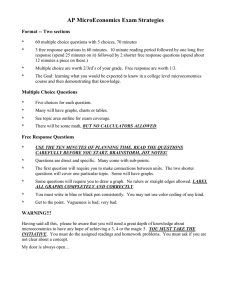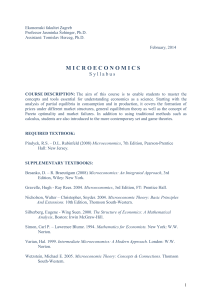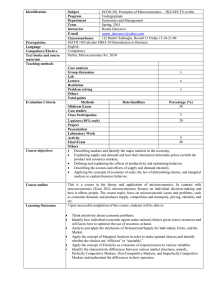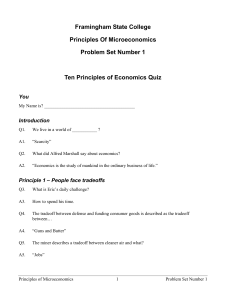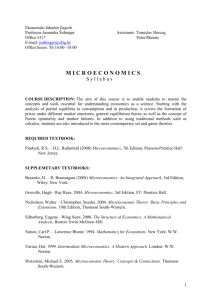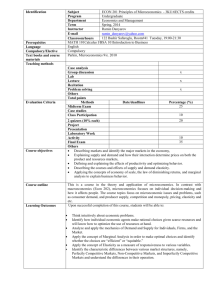MicroEconomics 2012 Spring
advertisement
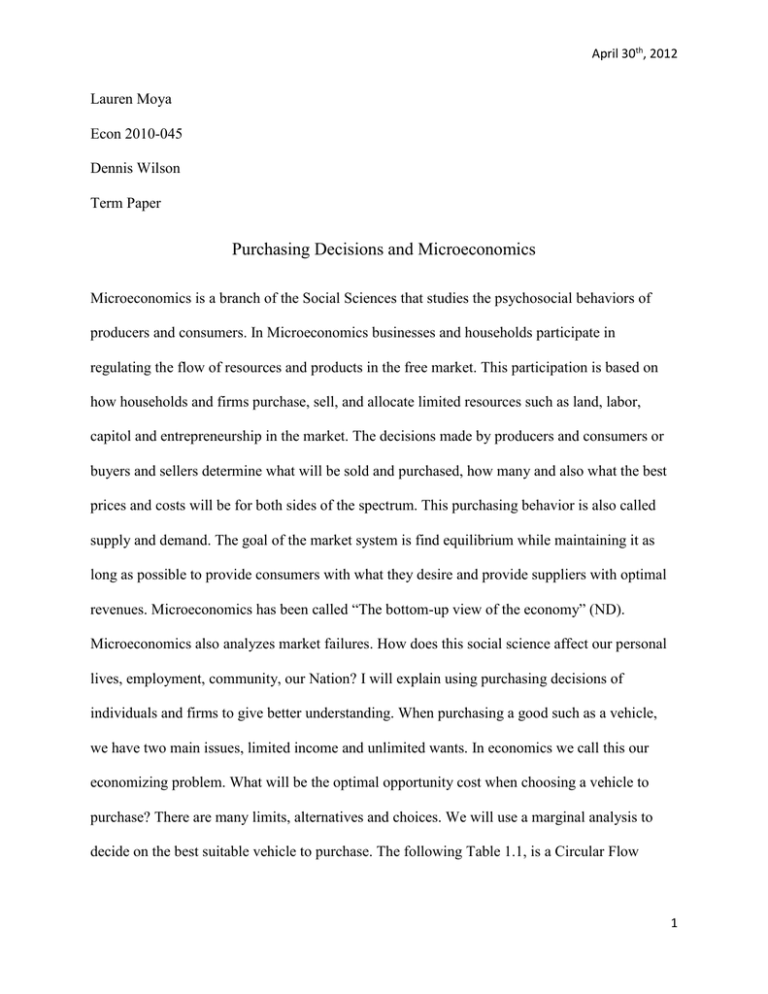
April 30th, 2012 Lauren Moya Econ 2010-045 Dennis Wilson Term Paper Purchasing Decisions and Microeconomics Microeconomics is a branch of the Social Sciences that studies the psychosocial behaviors of producers and consumers. In Microeconomics businesses and households participate in regulating the flow of resources and products in the free market. This participation is based on how households and firms purchase, sell, and allocate limited resources such as land, labor, capitol and entrepreneurship in the market. The decisions made by producers and consumers or buyers and sellers determine what will be sold and purchased, how many and also what the best prices and costs will be for both sides of the spectrum. This purchasing behavior is also called supply and demand. The goal of the market system is find equilibrium while maintaining it as long as possible to provide consumers with what they desire and provide suppliers with optimal revenues. Microeconomics has been called “The bottom-up view of the economy” (ND). Microeconomics also analyzes market failures. How does this social science affect our personal lives, employment, community, our Nation? I will explain using purchasing decisions of individuals and firms to give better understanding. When purchasing a good such as a vehicle, we have two main issues, limited income and unlimited wants. In economics we call this our economizing problem. What will be the optimal opportunity cost when choosing a vehicle to purchase? There are many limits, alternatives and choices. We will use a marginal analysis to decide on the best suitable vehicle to purchase. The following Table 1.1, is a Circular Flow 1 April 30th, 2012 Model which displays the continuous flow of goods, services, resources and money in the free market system. Microeconomics and Our Personal Lives. In the process of purchasing any item, in this case a vehicle, assuming other things are equal, a major factor in consumer decisions is when the price of an item goes up demand for that product goes down. Conversely the demand goes up when the price goes down. Keeping this in mind, producers supply vehicles in the most efficient way possible while meeting consumer tastes, demand and pricing. Another factor to add to consumer purchasing behavior is the opportunity cost, or the next best good or service that must be forgone to purchase the vehicle. For example if one has $10,000 to spend, he must decide that purchasing a vehicle is the optimal choice rather than spending that money on anything else that $10,000 can purchase. Consumer purchasing decisions are also driven by psychological, cultural and social factors all of which play a role in influencing preferences. Brand loyalty and preference also play a part in consumer purchasing 2 April 30th, 2012 behaviors ("Investopedia ULC"). So how do we look at purchasing a vehicle through a marginal analysis? We compare or analyze the benefits and the costs. The optimal choice in finding the “perfect” vehicle is when our marginal benefit is equal to our marginal cost, MB=MC. In order to maximize satisfaction, the consumer should allocate his money so that the last dollar spent on a particular vehicle produces the same amount of utility he would gain of it were spent on something else. To formulate this hypothesis you can take – the marginal utility of product A (vehicle) and divide it by the price of A then take the marginal utility of the product B (forgone good) and divide it by the price of B. If the consumer is spending his money to maximize utility the result of product A and B will be equal. In looking at Table 1.1, we see that in microeconomics households provide land, labor, capitol and entrepreneurial ability to the resource market. In turn, businesses purchase these services from the resource market to provide goods and services in the product market. Where do we find a vehicle? In the product market! In reading daily newspapers or listening to talk shows on the radio the majority of the topics are dealing with Economics. Issues such as politics, income equality, agriculture, business, employment, personal and public finance, are all a part of a circular flow system in which we all take part. Our personal decisions directly affect the bigger picture. Microeconomics is specifically the part of economics about single factors and the effects of individual decisions in our personal lives. 3 April 30th, 2012 Microeconomics and Employment. How do employment and purchasing decisions fit into microeconomics? In market economies, for example the United States, businesses require resources such as labor to produce. In obtaining labor the firm makes monetary payments to workers. Businesses take into account all costs of production including explicit costs to the owners of resources not owned by the firm such as labor, and implicit costs which are the opportunity costs of resources forgone to run the particular business. Implicit costs added to explicit costs for a business are called Economic Costs. Economic Profit is when total revenue exceeds total costs. (=explicit costs + implicit costs, including normal profit). There are also variable costs such as costs of resources purchased to be used to create the product which is being sold. There are Total costs which are the sum of total fixed costs and total variable costs. So, TC=TFC+TVC. In the short run you have other costs that need to be maintained and measured by per unit or average cost functions. Average fixed costs = TFC divided by Quantity. Average Variable Costs = TVC divided by Quantity. Average Total Costs = TC divided by Quantity. Marginal Costs = Average TC divided by Average Quantity. All of these functions will help follow productivity and costs for business in the short run. When marginal cost meet average total cost you are running at efficiency rates. Table 1.1 illustrates how Businesses purchase labor, land, capitol and entrepreneurial abilities from the resource market. Those costs flow into households as income and wages. The income is used in the product market to purchase goods and services. Money flow’s back into the businesses as revenue. Revenue is where you receive your payment for labor and entrepreneurial ability. Employment is essential to the function of the free market system to maintain balance in the economy. That employment resource is where you earn wages to purchase the vehicle that is being produced and sold in the product market. 4 April 30th, 2012 Microeconomics and Our Community. I have mentioned that at times the market has failures. When these failures occur the Government intervenes. How does this affect our community? The Government provides public goods which are known as a free good or service. However we will see that public goods in essence are never free. We recognize public goods by non-rivalry and non-excludability. Non-rivalry public goods are those which when are consumed are not reducing the availability of the same good to others. Non-excludability goods are those which cannot be confined to those who have paid for it. For example, health care. Some may purchase health care and some may be provided healthcare through government at no cost to that individual. Some other examples of public goods are education, street lighting, or national defense. Some public goods however do not necessarily exhibit fully the feature of non-excludability or non-rivalry. For example, public streets or highways are a public good but may become congested and therefore exhibit excludability or even rivalry for use (Brue, Flynn, and McConnell). When the government comes in to regulate market failures they either correct negative externalities such as air pollution or they correct positive externalities. The government corrects negative externalities through either direct control such as passing a law or regulation that forces a producer to stop producing at some point to stop air pollution or lessen air pollution. The government can also impose a tax to help regulate negative externalities. To correct positive externalities the government may impose subsidies and or government provision. In the reallocation of goods process the government taxes individuals and businesses and then takes the money and spends it on public goods. This is the basic function of the government in the free market. 5 April 30th, 2012 Microeconomics and Our Nation. Essentially Microeconomics determines how small economic components are affecting the broader economy of the Nation. Microeconomics begins with the study of demand based on a single individual and expanding outward to households, business, corporations, States and the entire Nation and eventually deals with international trade. Microeconomics establishes the way that goods and services are demanded and supplied as well as the distribution of limited resources throughout our Nation. States interact with each other to prioritize the impact of demand and supply and prioritize efficiencies in the market to prevent imbalances or full market failures. For example, Chrysler manufactures cars in Sterling Heights Michigan and supplies these well made cars to businesses in individual states for example California, to be sold to individuals with the willingness to pay for the particular vehicle. Markets may be local, international or national. The key features of the market system consist of private property rights, freedom of enterprise self-interest and competition. Property rights encourage individuals to make mutually agreeable economic transactions. The market system encourages self-interest. Competition constricts economic power to limit the actions of any single seller in the market, which enables equilibrium and balance. Producer output is determined by profits which depend mostly on consumer preferences. Profit also determines what will be produced and at which price. What impacts purchasing decisions in our nation? Purchasing decisions are impacted by social media, changes in packaging sizes and subtle messages called nudging among several other influencing factors. Some determinants of demand are changes in consumer tastes, changes in number of buyers, and changes in income changes in prices of related goods and changes in consumer expectations. Changes in income do not have much effect on normal products such as food or toilet paper. It 6 April 30th, 2012 will be purchased no matter what the cost. Changes in purchasing inferior goods such as televisions or new cars will change when income changes. Along with consumer tastes and changes is income the substitution effect arises. For example if chicken is on sale and one prefers beef they will choose the chicken because of opportunity cost. Determinants of supply are changes in: resource pricing, technology, number of sellers, taxes and subsidies, prices of other goods and producer expectations. Nationwide supply and demand are basically the essence of the market system. Conclusion Microeconomics is a function of small decisions in supply and demand which drive the economy in the bigger picture. Businesses and households participate in a circular flow in which goods and services are bought and sold in the product market as well as in the resource market. The economizing problem is that consumers have unlimited wants and limited incomes. Considering this fact, purchasing decisions are regulated based on limited income and scarce resources, employment, the rules and regulations of communities and nationwide economic strategies rooted in fair exchanges dealing with supply and demand. Employment is an essential component in the flow of the market system to fairly exchange monetary payments for labor and entrepreneurial abilities. Businesses follow precise cost strategies to run firms which supply the wants of consumers. Businesses understand that revenue from particular goods or services are the only way to decide what needs to be produced, how much and where it needs to be produced within our nation. Communities share in the distribution of resources and products along with public goods provided by the government such as education and training, street lighting, enforcement laws and national defense. All of these components comprise the free market system in which we are free to make choices based on self-interest and national interest to 7 April 30th, 2012 maintain a free society. Microeconomics brings equilibrium in a fair market where we can live in peace and feel free to decide what we would like to consume or produce to maximize marginal utility and preferences between individual of our nation, firms and even entire industries. Lauren Moya 8 April 30th, 2012 Bibliography ND, . "Science Daily." Microeconomics. N.p., 2010. Web. 26 Apr 2012. <http://www.sciencedaily.com/articles/m/microeconomics.htm>. Table 1.1 Web, retrieved from Google images; . "Microeconomics." Investopedia ULC. Online Magazine, 2012. Web. 26 Apr 2012. <http://www.investopedia.com/university/microeconomics/microeconomics3.asp Brue, Stanley L, Sean M Flynn, and Campbell R McConnell. Microeconomics. Salt Lake Community College. McGraw Hill, 2010. 9

